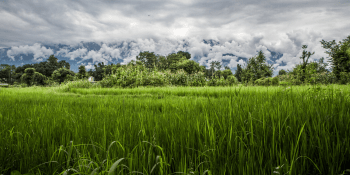Mapping Political Influence
A new CCAFS strategy for Progressive Adaptation involves use of IIED power tools to map circles of political influence in different countries. The visual exercise aims to improve understanding of how to best lobby for for enabling policies for climate change adaptation.
One of the greatest challenges for the climate change adaptation community is to ensure that technology and research are funneled down to the field and transformed into real-world change. It is a bridge that is difficult to build, and even today, after many crop breeding advancements, substantial yield gaps exist. In part, this is due to the "climate conundrum," in which weather variability and systemic poverty are self-reinforcing: Poor farmers are often risk-averse, often choosing not to invest in new technologies and opting for less risky but also less profitable crops. Meanwhile, climate risk also limits farmers' access to credit, since lenders fear loan defaults. Thus even weather shocks occurring once in every 5-6 years can limit potential growth in all years.
To address these issues, farmers must be given enough of a security net to make those risks worthwhile. In other words, technology and know-how are not enough; enabling policies must also exist.
But as a non-profit or a research institute, how do you influence policy? How do you know who holds the power?
Recently, CCAFS Theme on Progressive Adaptation trialed a "stakeholder influence mapping" power tool to answer just those questions. The policy power tool, developed by the International Institute for Environment and Development (IIED), is a "simple visual tool to examine and display the relative influence that different individuals and groups have overdecision-making, and how influence and cooperation change over time. It can be used as part of discussion or negotiation among stakeholders." Essentially, the tool consists of circles representing different stakeholder groups or individuals, which are then arranged in a pyramid. Influence is shown in the relative closeness of the circles to the policy apex, while relationships (degree of cooperation/conflict, etc.) are indicated by relative proximity and overlap of the circles. Local stakeholders and non-profits can come together to construct this map, and in doing so, learn what the most effective pathways to policy change may be.
See examples below from the IIED:


At the end of August, a CCAFS member met with such stakeholders in Uganda to complete this mapping exercise. The session was extremely fruitful, revealing information such as:
- Researchers are fairly well linked with national policy makers but disconnected from implementing agencies on the ground. This is just one aspect of a bigger problem, namely that preparation of policies and plans has become a business in itself – central government officials are much more accountable to produce the policy documents than they are to create change on the ground.
- The President has the strongest direct influence on what farmers do. Thus, getting the ear and capturing the imagination of the President would be the most surefire way of getting agricultural policy to help small-scale farmers adapt to climate change.
- Many of the agencies and committees tasked with climate change responsibilities have huge untapped potential. Building active and astute coalitions among researchers, agricultural extension agents, NGOs and farmers’ organizations (such as the national Farmers’ Federation) would be a major step towards making agricultural research work in support of adaptation.
The next step will be to repeat this exercise in other countries.


